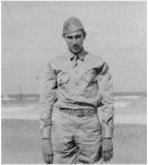

116th Infantry, 29th Division, Company F
The invasion of Normandy began June 6, 1944. Code named Operation Overlord, the landing involved 4,100 landing craft. General Eisenhower told the troops, “You are about to embark upon a great crusade, toward which we’ve striven these many months.”
Among those involved in the “great crusade” was nineteen year old draftee PFC John J. Sauer, Sr. of Baltimore City, MD. John entered the service attached to the Army Air Corp. Shortly after landing in England, the group was assembled and names were called. Those called were asked to step forward and were told that they had been re-assigned to an infantry division, a division which would be trained for an invasion. Each man was to send all his personal articles home, keeping only his toiletries. Soon they were shipped to England’s White Cliffs of Dover, where they were trained in climbing and techniques of boarding ships and landing craft.
On the morning of the invasion, John’s landing craft headed toward Omaha Beach. When the vessel hit a sand bar, the crew assumed it was the beach itself. They lowered the gate, and thirty men plunged into eighteen feet of water. All perished, except John, who dropped his rifle and scuttled along the sea floor until his breath ran out. As he surfaced, he heard a cry for help and saw someone clinging to a steel structure known as a “Czech hedgehog” in the water. John swam to aid the person, who told John he couldn’t swim. He also said he was a war correspondent. John helped him to the beach and went back for the man’s typewriter.
Shortly after his return to the beach, John was told by a corpsman attending to the many wounded that he would warn him of incoming shells. Although the warning came, it came too late, and John was hit by shrapnel from a German 88mm. His next recollection was of being on a hospital ship.
Those who landed on Omaha Beach faced the elite German 352nd Infantry, the most heavily fortified unit present, which was entrenched on high bluffs above the beach. Pre-bombardment had proven ineffective. The official record states, “Within ten minutes of the ramps being lowered, [the leading] company had become inert, leaderless, and almost incapable of action. Every officer and sergeant had been killed or wounded. It had become a struggle for survival and rescue.” American casualties at Omaha were around 3,000, most within the first few hours.
The hospital ship’s wards were divided in to three sections: critical, self-inflicted, and minor injuries. Although John’s injuries were considered minor, he was moved to the “self-inflicted” ward due to overcrowding. He was nearly arrested before he was able to explain his presence there.
Released from the hospital ten days later, John became part of a unit of fifty chosen to liberate a concentration camp near Nuremburg, Germany. Transported by train on a “40 and 8” car (so called because it held forty men or eight horses), they stopped about two miles short of their destination. German planes strafed the train, destroying the last two cars which contained all of the food and ammunition. It took two days for relief to arrive, relief limited to two clips of ammunition per man and C-rations.
At 3 AM the group was awakened and marched two miles, arriving at the camp by 4 AM. The highest ranking officer of the troop was a sergeant; John, a PFC, was second in command. The orders were to liberate the camp and take no prisoners.
As they marched along the five or six hundred feet of road from the camp gate to the crematorium, they found bodies piled eight to ten feet high on each side of the road; the stench of death was everywhere. The defenders of the camp were all in their teens. John said, “There wasn’t a soldier among them; they were all kids.”
Suddenly a siren wailed, and the liberators were told that that signified another gassing was about to take place. Fortunately, for five hundred people (clergy, Poles, and Jews), the rescuers arrived in time to save them. The unit remained at that sight for another two months to “mop up” the area. After returning home, John guarded German prisoners in Philadelphia, PA, for three weeks to complete his service obligation.
For his heroic actions during the Normandy invasion, John received a Purple Heart and Bronze Star. He also received a Good Conduct Medal, Expert Infantry Combat Badge, and Europe-Africa-Mideast Campaign Ribbon. France also awarded him a medal for participating in the liberation of that country.
Stateside, John served thirty years on the Baltimore City Fire Department, where he received a commendation for saving five people. He was one of six survivors of a building collapse in which he was trapped for fourteen hours, and was named Baltimore Firefighter of the Year in 1976. He also delivered seven babies during his career. John and his wife, Joan, will have been married for sixty years in June 2008. They have five children, nine grandchildren, and two great-children. John served for twenty-five years as Captain of the Color Guard of American Legion Post 166 of Ocean City, MD. He has been dubbed by his peers as “Captain Emeritus” of that group.
As told to Allan G. Kastner
